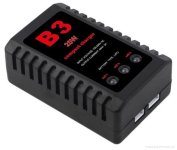Hi lithium enthusiasts...
After the new 20s3p 84v lg mh1 pack is finished (and hooked up to the original bms) I will have balancing leads going out from the pack.
I've heard that this original bms dosn't really balance the cells. Even if it does it can't handle large imbalances. Anyway I need to keep it as it's communicating with the controller of the vehicle.
The aim is to get the pack very balanced cell-wise and then balance it with the four 5s balance leads on an external hobby charger every few weeks/months.
Because there arent any 20s balance chargers, and because it won't be balanced often I was thinking of putting together a simple cheap solution of several smaller chargers.
To avoid ground shorting the pack through the chargers I need them run directly on the mains so they are isolated from eachother (behind a transformer).
I know this sounds crazy but there are 3-4usd 3s chargers (using only the balance leads) that run directly from the mains. Lets say I get 2/4/7 of these and balance 5/10/20s at a time.
To minimize the risk of one of the 20 charging circuits to fail I was thinking I can minimize risk by getting two 3s chargers and test the circuits and pick the 5 best ones of the 6 available (ending voltage as equal as possible).
Would this be a feasible solution? I know buying cheap chargers sounds crazy but only the cheap balance lead chargers have the individual charge circuits. I don't want to serial charge 3s @ 11v at a time then wait forever for balancing to bleed power around.
I don't really want to arrange an array of twenty 1s charger modules and twenty power supplies either. Seems these 3s ones are the largest ground isolated chargers available. Do you know of a better solution to balance the pack every now and then?
Thank you very much for reading and commenting. I really appreciate it..
/a
After the new 20s3p 84v lg mh1 pack is finished (and hooked up to the original bms) I will have balancing leads going out from the pack.
I've heard that this original bms dosn't really balance the cells. Even if it does it can't handle large imbalances. Anyway I need to keep it as it's communicating with the controller of the vehicle.
The aim is to get the pack very balanced cell-wise and then balance it with the four 5s balance leads on an external hobby charger every few weeks/months.
Because there arent any 20s balance chargers, and because it won't be balanced often I was thinking of putting together a simple cheap solution of several smaller chargers.
To avoid ground shorting the pack through the chargers I need them run directly on the mains so they are isolated from eachother (behind a transformer).
I know this sounds crazy but there are 3-4usd 3s chargers (using only the balance leads) that run directly from the mains. Lets say I get 2/4/7 of these and balance 5/10/20s at a time.
To minimize the risk of one of the 20 charging circuits to fail I was thinking I can minimize risk by getting two 3s chargers and test the circuits and pick the 5 best ones of the 6 available (ending voltage as equal as possible).
Would this be a feasible solution? I know buying cheap chargers sounds crazy but only the cheap balance lead chargers have the individual charge circuits. I don't want to serial charge 3s @ 11v at a time then wait forever for balancing to bleed power around.
I don't really want to arrange an array of twenty 1s charger modules and twenty power supplies either. Seems these 3s ones are the largest ground isolated chargers available. Do you know of a better solution to balance the pack every now and then?
Thank you very much for reading and commenting. I really appreciate it..
/a


